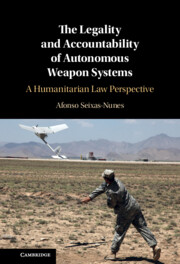Book contents
- The Legality and Accountability of Autonomous Weapon Systems
- The Legality and Accountability of Autonomous Weapon Systems
- Copyright page
- Dedication
- Contents
- Acknowledgements
- Abbreviations
- Introduction
- 1 Introducing Autonomous Systems of War
- 2 AWS
- 3 Autonomous Weapon Systems and ‘Autonomy’
- 4 AWS and the IHL Requirements
- 5 Accountability and Liability for the Deployment of Autonomous Weapon Systems
- Final Conclusion
- Index
4 - AWS and the IHL Requirements
Published online by Cambridge University Press: 05 May 2022
- The Legality and Accountability of Autonomous Weapon Systems
- The Legality and Accountability of Autonomous Weapon Systems
- Copyright page
- Dedication
- Contents
- Acknowledgements
- Abbreviations
- Introduction
- 1 Introducing Autonomous Systems of War
- 2 AWS
- 3 Autonomous Weapon Systems and ‘Autonomy’
- 4 AWS and the IHL Requirements
- 5 Accountability and Liability for the Deployment of Autonomous Weapon Systems
- Final Conclusion
- Index
Summary
Traditionally it is argued that AWS are a challenge for IHL, but Chapter 4 pleads the opposite. IHL principles and rules are long and well-established and, therefore, it is up to roboticists to prove that AWS will reliably comply with IHL. For this reason, the chapter begins with an analysis of the inherent values of IHL and the two orders of requirements established in IHL in order to guarantee the legitimacy of AWS. First, a priori requirements that concern the legitimacy of AWS as weapons per se (Article 35 and 36 API). The second set of requirements are a posteriori; they regard the legitimate use of AWS. In this respect, a thorough analysis of the rules of Precaution (Article 57 API), Distinction (Articles 49; 51; 52 API) and Proportionality (Articles 51(5)(b) and 57(5)(a)(iii) API) is provided. While the rules of Precaution enshrine the obligations impending upon military commanders, other rules, such as the Principle of Distinction and Proportionality, pose specific challenges in how AWS will be able to comply with such rules. For that purpose, the chapter looks at new technological developments which may facilitate the compliance with the IHL rules (facial recognition; collateral damage estimative methodology), but by no means insure respect for IHL in all circumstances.
- Type
- Chapter
- Information
- The Legality and Accountability of Autonomous Weapon SystemsA Humanitarian Law Perspective, pp. 140 - 190Publisher: Cambridge University PressPrint publication year: 2022

